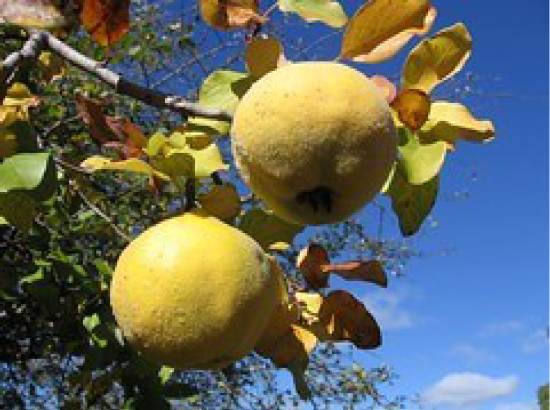9.4: Melons and Pomes
- Page ID
- 21622
\( \newcommand{\vecs}[1]{\overset { \scriptstyle \rightharpoonup} {\mathbf{#1}} } \)
\( \newcommand{\vecd}[1]{\overset{-\!-\!\rightharpoonup}{\vphantom{a}\smash {#1}}} \)
\( \newcommand{\id}{\mathrm{id}}\) \( \newcommand{\Span}{\mathrm{span}}\)
( \newcommand{\kernel}{\mathrm{null}\,}\) \( \newcommand{\range}{\mathrm{range}\,}\)
\( \newcommand{\RealPart}{\mathrm{Re}}\) \( \newcommand{\ImaginaryPart}{\mathrm{Im}}\)
\( \newcommand{\Argument}{\mathrm{Arg}}\) \( \newcommand{\norm}[1]{\| #1 \|}\)
\( \newcommand{\inner}[2]{\langle #1, #2 \rangle}\)
\( \newcommand{\Span}{\mathrm{span}}\)
\( \newcommand{\id}{\mathrm{id}}\)
\( \newcommand{\Span}{\mathrm{span}}\)
\( \newcommand{\kernel}{\mathrm{null}\,}\)
\( \newcommand{\range}{\mathrm{range}\,}\)
\( \newcommand{\RealPart}{\mathrm{Re}}\)
\( \newcommand{\ImaginaryPart}{\mathrm{Im}}\)
\( \newcommand{\Argument}{\mathrm{Arg}}\)
\( \newcommand{\norm}[1]{\| #1 \|}\)
\( \newcommand{\inner}[2]{\langle #1, #2 \rangle}\)
\( \newcommand{\Span}{\mathrm{span}}\) \( \newcommand{\AA}{\unicode[.8,0]{x212B}}\)
\( \newcommand{\vectorA}[1]{\vec{#1}} % arrow\)
\( \newcommand{\vectorAt}[1]{\vec{\text{#1}}} % arrow\)
\( \newcommand{\vectorB}[1]{\overset { \scriptstyle \rightharpoonup} {\mathbf{#1}} } \)
\( \newcommand{\vectorC}[1]{\textbf{#1}} \)
\( \newcommand{\vectorD}[1]{\overrightarrow{#1}} \)
\( \newcommand{\vectorDt}[1]{\overrightarrow{\text{#1}}} \)
\( \newcommand{\vectE}[1]{\overset{-\!-\!\rightharpoonup}{\vphantom{a}\smash{\mathbf {#1}}}} \)
\( \newcommand{\vecs}[1]{\overset { \scriptstyle \rightharpoonup} {\mathbf{#1}} } \)
\( \newcommand{\vecd}[1]{\overset{-\!-\!\rightharpoonup}{\vphantom{a}\smash {#1}}} \)
\(\newcommand{\avec}{\mathbf a}\) \(\newcommand{\bvec}{\mathbf b}\) \(\newcommand{\cvec}{\mathbf c}\) \(\newcommand{\dvec}{\mathbf d}\) \(\newcommand{\dtil}{\widetilde{\mathbf d}}\) \(\newcommand{\evec}{\mathbf e}\) \(\newcommand{\fvec}{\mathbf f}\) \(\newcommand{\nvec}{\mathbf n}\) \(\newcommand{\pvec}{\mathbf p}\) \(\newcommand{\qvec}{\mathbf q}\) \(\newcommand{\svec}{\mathbf s}\) \(\newcommand{\tvec}{\mathbf t}\) \(\newcommand{\uvec}{\mathbf u}\) \(\newcommand{\vvec}{\mathbf v}\) \(\newcommand{\wvec}{\mathbf w}\) \(\newcommand{\xvec}{\mathbf x}\) \(\newcommand{\yvec}{\mathbf y}\) \(\newcommand{\zvec}{\mathbf z}\) \(\newcommand{\rvec}{\mathbf r}\) \(\newcommand{\mvec}{\mathbf m}\) \(\newcommand{\zerovec}{\mathbf 0}\) \(\newcommand{\onevec}{\mathbf 1}\) \(\newcommand{\real}{\mathbb R}\) \(\newcommand{\twovec}[2]{\left[\begin{array}{r}#1 \\ #2 \end{array}\right]}\) \(\newcommand{\ctwovec}[2]{\left[\begin{array}{c}#1 \\ #2 \end{array}\right]}\) \(\newcommand{\threevec}[3]{\left[\begin{array}{r}#1 \\ #2 \\ #3 \end{array}\right]}\) \(\newcommand{\cthreevec}[3]{\left[\begin{array}{c}#1 \\ #2 \\ #3 \end{array}\right]}\) \(\newcommand{\fourvec}[4]{\left[\begin{array}{r}#1 \\ #2 \\ #3 \\ #4 \end{array}\right]}\) \(\newcommand{\cfourvec}[4]{\left[\begin{array}{c}#1 \\ #2 \\ #3 \\ #4 \end{array}\right]}\) \(\newcommand{\fivevec}[5]{\left[\begin{array}{r}#1 \\ #2 \\ #3 \\ #4 \\ #5 \\ \end{array}\right]}\) \(\newcommand{\cfivevec}[5]{\left[\begin{array}{c}#1 \\ #2 \\ #3 \\ #4 \\ #5 \\ \end{array}\right]}\) \(\newcommand{\mattwo}[4]{\left[\begin{array}{rr}#1 \amp #2 \\ #3 \amp #4 \\ \end{array}\right]}\) \(\newcommand{\laspan}[1]{\text{Span}\{#1\}}\) \(\newcommand{\bcal}{\cal B}\) \(\newcommand{\ccal}{\cal C}\) \(\newcommand{\scal}{\cal S}\) \(\newcommand{\wcal}{\cal W}\) \(\newcommand{\ecal}{\cal E}\) \(\newcommand{\coords}[2]{\left\{#1\right\}_{#2}}\) \(\newcommand{\gray}[1]{\color{gray}{#1}}\) \(\newcommand{\lgray}[1]{\color{lightgray}{#1}}\) \(\newcommand{\rank}{\operatorname{rank}}\) \(\newcommand{\row}{\text{Row}}\) \(\newcommand{\col}{\text{Col}}\) \(\renewcommand{\row}{\text{Row}}\) \(\newcommand{\nul}{\text{Nul}}\) \(\newcommand{\var}{\text{Var}}\) \(\newcommand{\corr}{\text{corr}}\) \(\newcommand{\len}[1]{\left|#1\right|}\) \(\newcommand{\bbar}{\overline{\bvec}}\) \(\newcommand{\bhat}{\widehat{\bvec}}\) \(\newcommand{\bperp}{\bvec^\perp}\) \(\newcommand{\xhat}{\widehat{\xvec}}\) \(\newcommand{\vhat}{\widehat{\vvec}}\) \(\newcommand{\uhat}{\widehat{\uvec}}\) \(\newcommand{\what}{\widehat{\wvec}}\) \(\newcommand{\Sighat}{\widehat{\Sigma}}\) \(\newcommand{\lt}{<}\) \(\newcommand{\gt}{>}\) \(\newcommand{\amp}{&}\) \(\definecolor{fillinmathshade}{gray}{0.9}\)Melons
Like pumpkins and cucumbers, melons are members of the gourd family (Cucurbitaceae). The dozens of melon varieties can be divided into two general types: sweet (or dessert) melons and watermelons. Sweet melons have a tan, green or yellow netted or furrowed rind and dense, fragrant flesh. Watermelon has a thick, dark green rind surrounding crisp, watery flesh.
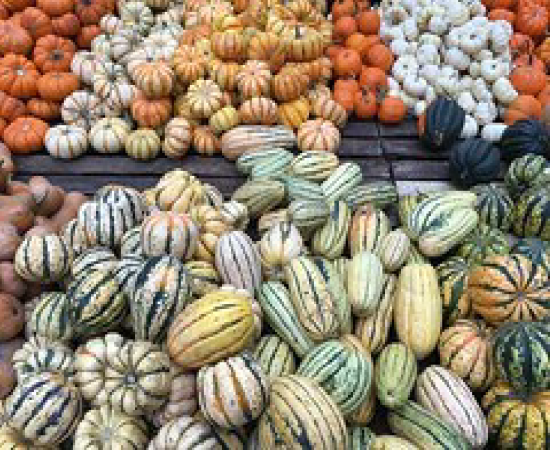
Melons are almost 90 percent water, so cooking destroys their texture, quickly turning the flesh to mush. Most are served simply sliced, perhaps with a bit of lemon or lime juice. Melons also blend well in fruit salads or with rich, cured meats such as prosciutto. Melons may be pureed and made into sorbet or chilled, uncooked soup.
Melons should be vine-ripened. A ripe melon should yield slightly and spring back when pressed at the blossom end (opposite the stem). It should also give off a strong aroma. Avoid melons that are very soft or feel damp at the stem end. Ripe melons may be stored in the refrigerator, although the flavor will be better at room temperature. Slightly under-ripe melons can be stored at room temperature to allow flavor and aroma to develop.
Cantaloupes
American cantaloupes, which are actually muskmelons, are sweet melons with a thick, yellow-green netted rind, a sweet, moist, orange flesh and a strong aroma. (European cantaloupes, which are not generally available in this country, are more craggy and furrowed in appearance.) As with all sweet melons, the many small seeds are found in a central cavity. Cantaloupes are excellent for eating alone and are especially good with ham or rich meats.
Avoid cantaloupes with the pronounced yellow color or moldy aroma that indicates over-ripeness. Mexican imports ensure a year-round supply, although their peak season is summer.
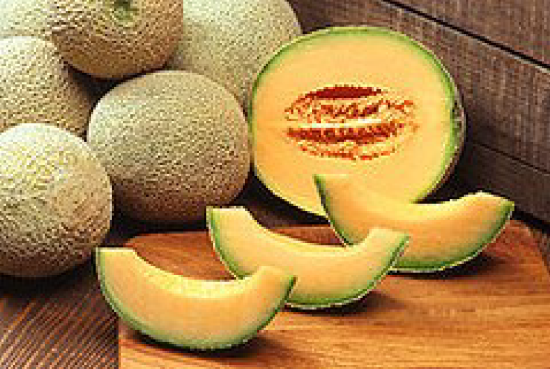
Casaba Melons
The casaba melon is a teardrop-shaped sweet melon. It has a coarse, yellow skin and a thick, ridged rind; its flesh is creamy white to yellow. Casaba melons are used like cantaloupes. Casaba melons do not have an aroma, so selection must be based on a deep skin color and the absence of dark or moist patches. Their peak season is during September and October.
Crenshaw Melons
Crenshaw (or cranshaw) melons have a mottled, green-yellow ridged rind and orange-pink flesh. They are large pear-shaped sweet melons with a strong aroma. The flesh has a rich, spicy flavor and may be used like cantaloupe. Crenshaws are available from July through October; their peak season is during August and September.
Honeydew Melons
Honeydew melons are large oval sweet melons with a smooth rind that ranges from white to pale green. Although the flesh is generally pale green, with a mild, sweet flavor, pink-or gold-fleshed honeydews are also available. Like casaba melons, honeydew melons have little to no aroma. They are available almost all year; their peak season is from June through October.
Santa Claus Melons
Santa Claus or Christmas melons are large, elongated sweet melons with a green-and-yellow-striped, smooth rind. The flesh is creamy white or yellow and tastes like casaba. They are a winter variety, with peak availability during December, which explains the name.
Watermelons
Watermelons are large (up to 30 pounds or 13.5 kilograms) round or oval-shaped melons with a thick rind. The skin may be solid green, green-striped or mottled with white. The flesh is crisp and extremely juicy with small, hard, black seeds throughout. Seedless hybrids are available. Most watermelons have pink to reel flesh, although golden-fleshed varieties are becoming more common. Watermelons are of a different genus from the sweet melons described earlier. They are native to tropical Africa but grow commercially in Texas and several southern states.
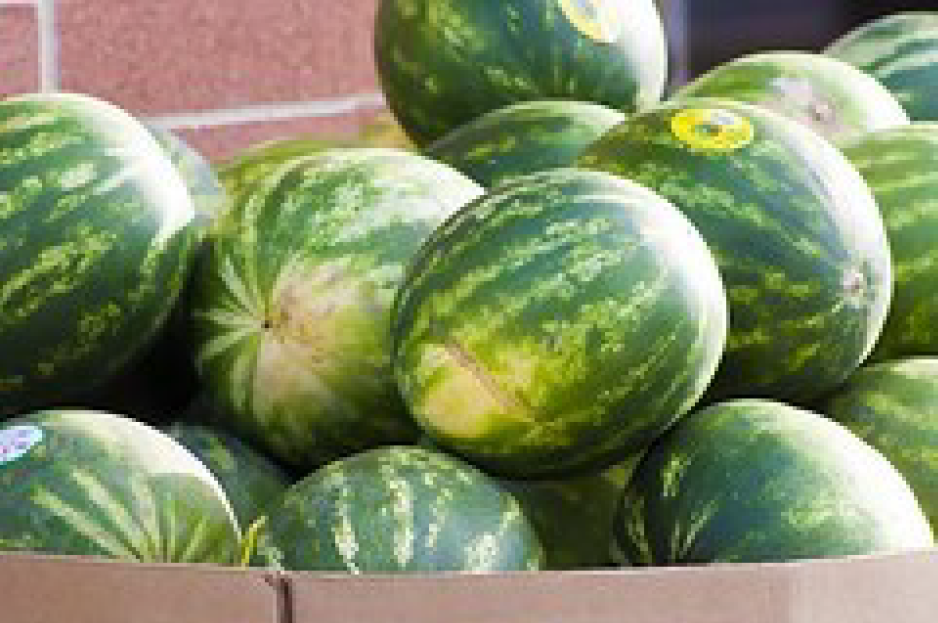
Pomes
Pomes are tree fruits with thin skin and firm flesh surrounding a central core containing many small seeds called pips or carpels. Pomes include apples, pears and quince.
Apples
Apples, perhaps the most common and commonly appreciated of all fruits, grow on trees in temperate zones worldwide. They are popular because of their convenience, flavor, variety and availability.
Apples can be eaten raw out of hand, or they can be used in a wide variety of cooked or baked dishes. They are equally useful in breads, desserts or vegetable dishes and go well with game, pork and poultry. Classic dishes prepared with apples are often referred to as a la Normande. Apple juice (cider) produces alcoholic and nonalcoholic beverages and cider vinegar.
Of the hundreds of known apple varieties, only 20 or so are commercially significant in the United States. Most have a moist, creamy white flesh with a thin skin of yellow, green or red. They range in flavor from very sweet to very tart, with an equally broad range of textures, from firm and crisp to soft and mealy.
In Europe, apples are divided into distinct cooking and eating varieties. Cooking varieties are those that disintegrate to a puree when cooked. American varieties are less rigidly classified. Nevertheless, not all apples are appropriate for all types of cooking. Those that retain their shape better during cooking are the best choices when slices or appearances are important. Varieties with a higher malic acid content break down easily, malting them more appropriate for applesauce or juicing. Either type may be eaten out of hand, depending on personal preference.
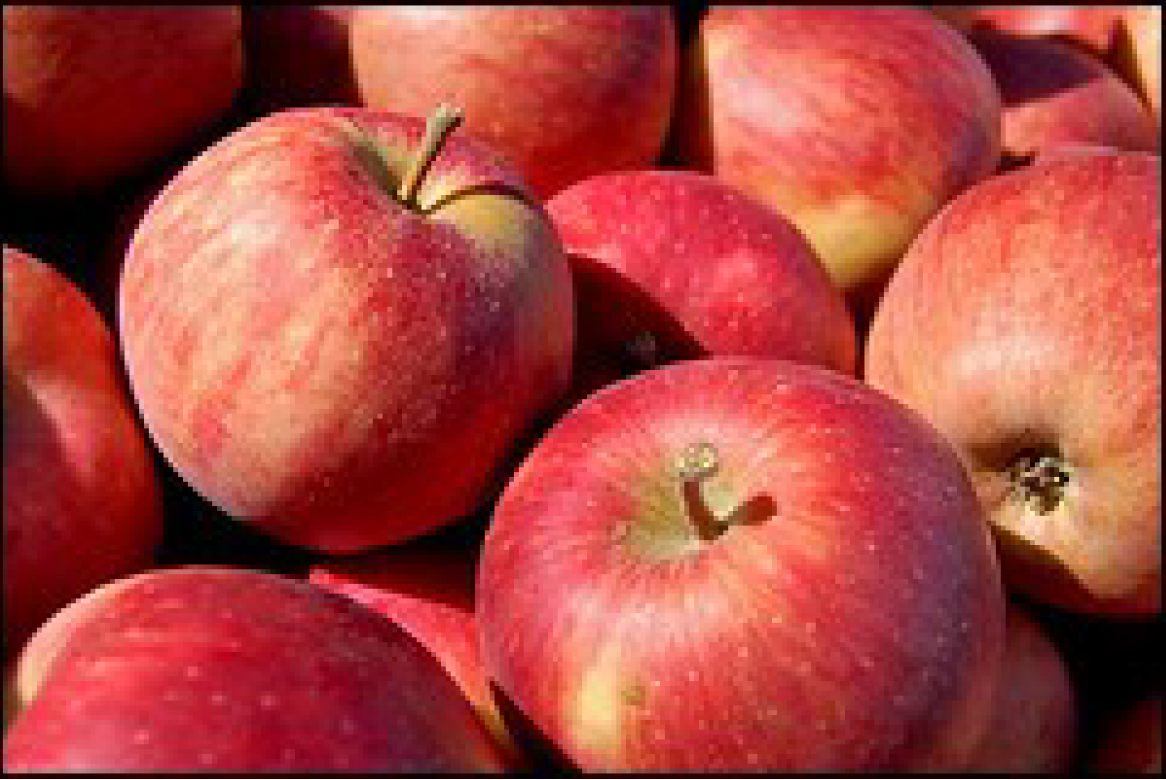
Varieties of Apples
| Variety | Skin Color | Flavor | Peak Season | Use |
|---|---|---|---|---|
| Fiji | Yellow-green with red highlights | Sweet-spicy | All year | Eating, in salads |
| Gala | Yellow-orange with red stripes | Sweet | August - March | Eating, in salads, sauce |
| Golden Delicious | Glossy, greenish-gold | Sweet | September - October | In tarts, with cheese, in salads |
| Granny Smith | Bright green | Tart | October - November | Eating, in tarts |
| Jonathan | Brilliant red | Tart to acidic | September - October | Eating, all-purpose |
| McIntosh | Red with green background | Tart to acidic | Fall | Applesauce, in closed pies |
| Pippin (Newton) | Greenish-yellow | Tart | Fall | In pies, eating, baking |
| Red Delicious | Deep red | Sweet but bland | September - October | Eating |
| Rome | Red | Sweet-tart | October - November | Baking, pies, sauces |
| Winesap | Dark red with streaks | Tangy | October - November | Cider, all-purpose |
Although not native to North America, apples are now grown commercially in 35 states, with Washington and New York leading in production. Apples are harvested when still slightly under-ripe, then stored in a controlled atmosphere (temperature and oxygen are greatly reduced) for extended periods until ready for sale. Modern storage techniques make fresh apples available all year, although their peak season is during the autumn.
When selecting apples, look for smooth, unbroken skins and firm fruits, without soft spots or bruises. Badly bruised or rotting apples should be discarded immediately. They emit quantities of ethylene gas that speed spoilage of nearby fruits. (Remember the saying that "one bad apple spoils the barrel.") Store apples chilled for up to 6 weeks. Apple peels (the skin) may be eaten or removed as desired, but in either case, apples should be washed just prior to use to remove pesticides and any wax that was applied to improve appearance. Apple slices can be frozen (often with sugar or citric acid added to slow spoilage) or dried.
Pears
Pears are an ancient tree fruit grown in temperate areas throughout the world. Most of the pears marketed in the United States are grown in California, Washington and Oregon.
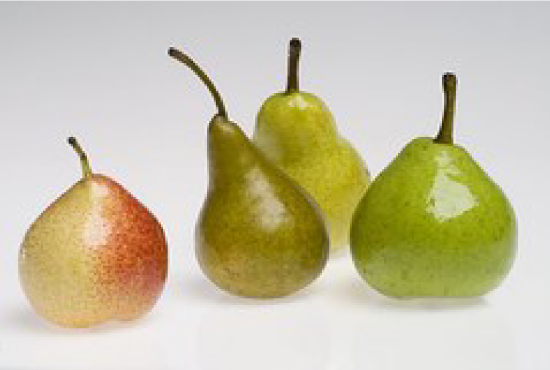
Pear Varieties
| Variety | Appearance | Flavor | Peak Season | Use |
|---|---|---|---|---|
| Anjou (Beurre d'Anjou) | Greenish-yellow skin; egg- shaped with short neck; red variety also available | Sweet and juicy | October - May | Eating, poaching |
| Bartlett (Williams) | Thin yellow skin; bell-shaped; red variety also available | Very sweet, buttery, juicy | August - December | Eating, canning, in salads |
| Bose | Golden-brown skin; long tapered neck | Buttery | September - May | Poaching, baking |
| Cornice | Yellow-green skin; large and chubby | Sweet, juicy | October - February | Eating |
| Sekel | Tiny; brown to yellow skin | Spicy | August - December | Poaching, pickling |
Although thousands of pear varieties have been identified, only a dozen or so are commercially significant. Pear varieties vary widely in size, color and flavor. They are generally eaten out of hand, baked, or poached. Pears are delicious with cheese, especially blue cheeses, and can be used in fruit salads, compotes or preserves. When selecting pears, look for fruits with smooth, unbroken skin and an intact stem.
Asian pears, also known as Chinese pears or apple-pears, are of a different species than common pears. They have the moist, sweet flavor of a pear and the round shape and crisp texture of an apple. They are becoming increasingly popular in the United States, particularly those known as Twentieth Century or Nijisseiki.
Pears will not ripen properly on the tree, so they are picked while still firm and should be allowed to soften before use. Under-ripe pears may be left at room temperature to ripen. A properly ripened pear should have a good fragrance and yield to gentle pressure at the stem end. Pears can be prepared or stored in the same ways as apples.
Quince
Common quince resemble large, lumpy yellow pears. Their flesh is hard, with many pips or seeds, and they have a wonderful fragrance. While too astringent to eat raw, quince develop a sweet flavor and pink color when cooked with sugar. Quince are used in meat stews, jellies, marmalades and pies. They have a high pectin content and may be added to other fruit jams or preserves to encourage gelling.
Fresh quince, usually imported from South America or southeast Europe, are available from October through January. Select firm fruits with a good yellow color. Small blemishes may be cut away before cooking. Quince will keep for up to a month under refrigeration.
